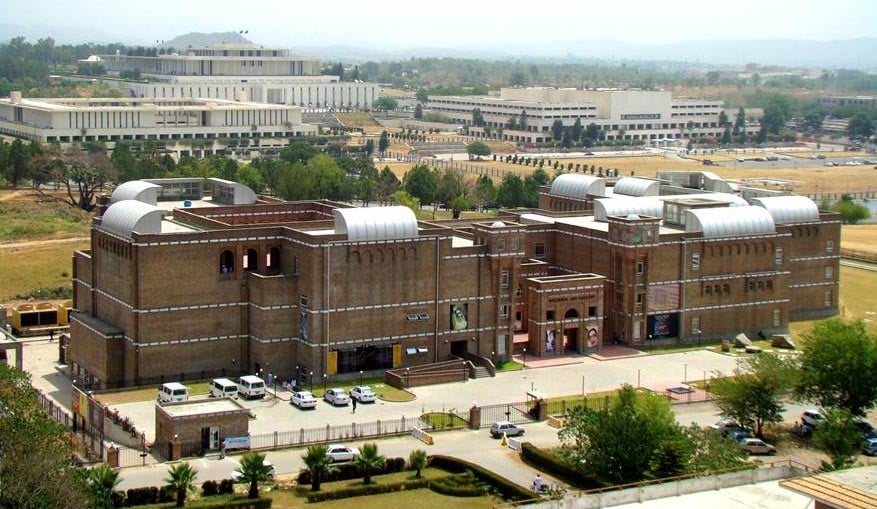
National Art Gallery has the work of Pakistan’s most prominent artists who have shaped the country’s art scene

It is September 6, the Defence Day. The lawns of National Art Gallery are filled with excited students. They have come from various colleges and universities of the twin cities of Rawalpindi and Islamabad, as well as from the Punjab University, Lahore and Hazara University. They are busy painting in groups for a competition organised by the Pakistan National Council of Arts (PNCA) to celebrate the Defence Day.
The themes assigned to these students are to represent the culture of different provinces of Pakistan.
Nida Younas, a student of Post Graduate College for Women, Rawalpindi is depicting the culture of Gilgit and Baltistan, along with her fellows. "This is the first time we are participating in such a competition and it is indeed a matter of pride," she says. "We often come here at for the exhibitions and workshops and it’s usually a good experience for us."
Behind Marriot Hotel and PTV Headquarters stands a tall and magnificent work of architecture called the National Art Gallery that functions under the administrative umbrella of PNCA.
The National Art Gallery has a collection of over 600 works of art, which has been built over the span of many years. The collection is a mixture of the work by Pakistan’s most prominent art practitioners, who are said to have set the traditions in Pakistan’s art scene, and the relatively new ones, who have achieved a certain level of excellence.
The primary objective of the National Art Gallery, as the Director Visual Art Division, Musarrat Nahid Imam describes is, "to bring in the best and the most contemporary work of art, hence presenting a true and soft image of Pakistan to the world at large, through the rich and vibrant collection of art."
"Before 2007, we had a set-up in the residential areas, moving here and there. It was a collective demand of the artists from all over the country to have a permanent place for them, where they could exhibit their work," says Imam. "We have dedicated one gallery to the work of Sadequain, but we need more space to exhibit his collection which is huge."
The National Art Gallery receives many requests for curated exhibitions -- both national and international. A work plan presented by the National Art Gallery includes annual exhibitions, seminars, workshops and lectures.
"In many universities and institutions, various genres of arts are taught but, due to various constraints, these institutions lack in technical training. We, at the National Art Gallery, offer workshops in which young artists from all over the country come and learn the new techniques," says Imam.
Baroosh Ahsan is a regular visitor of PNCA. "It is always a good experience for me to bring my children along with me. In an environment so suppressed, I find it a good refuge," she says. "The Gallery has an excellent collection which I find very productive."
Through embassies and international organisations, the foreign artwork is also exhibited at the National Art Gallery, as the local work is sent abroad.
"We get excellent response from foreign delegates, who visit the gallery as a part of their programmes," says Imam. A visit to the National Art Gallery is included in almost every tour of foreign dignitaries, both official and unofficial. Within Pakistan, from ISPR to Kashmir Council, almost every institution has collaborated with the National Art Gallery on issues ranging from Kashmir to climate change.
Amna Pataudi, who is the director of Shakir Ali Museum, says the National Art Gallery has proved very helpful for established artists and art lovers. "We can take our exhibitions from here (Lahore) to Islamabad, which often get good response there.
"Recently, we took the exhibition, "Massacre of Innocence", which was a huge show. Based on the theme of APS Peshawar massacre, the exhibition had work from some of the best artists from Lahore. We displayed it and held a seminar about it which got tremendous response," Pataudi says. "It was the artists’ way of depicting their grief and taking part in the national mourning."
Iqbal Geoffrey, who has won many awards and earned praises from all over the world for his work, criticises the current policies of the gallery. Resenting the "bureaucratic treatment of art", he says the appointments being made at PNCA are not reflective of merit.
"This will not help the art scene in Pakistan, but it will further deteriorate," he says.
The gallery has a huge collection of the works of Abdur Rehman Chughtai, Haji Muhammad Sharif, Ustad Allah Bakhsh, Shakir Ali, Zubeida Agha, Anna Molka Ahmed and Gulgee.
Naseem Basharat, an art instructor at a Rawalpindi-based institute, likes her experience at the gallery. "We often come here to participate and attend the workshops, which include the new art techniques and genres."
Earlier, Basharat says, there wasn’t enough government patronage for Pakistan’s artists’ community. "The National Art Gallery collaborates with different institutions regularly, offer support, which is indeed very helpful."
Musarrat Nahid Imam insists there are financial limitations but she hopes to expand the gallery’s operations.